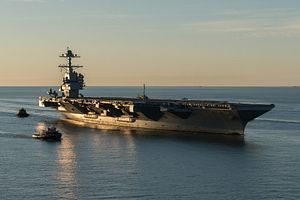The nuclear-powered aircraft carrier USS Gerald R. Ford (CVN-78), the lead of vessel of the U.S. Navy’s latest class of carriers, and the most expensive warship in U.S. history, just breached a USD$12.9 billion spending lid set by Congress by USD$120 million bringing total acquisition cost to $13.027 billion, the Navy said in a recent statement.
The additional USD$120 million will be needed to fix the aircraft carrier’s faulty Advanced Weapons Elevator used to transport ammunition from the lower to the upper decks, as well as to repair the the Ford’s propulsion system bearing, which broke down during sea trials in January, the U.S. Navy’s Naval Sea Systems Command said in a statement quoted by Bloomberg News on May 11. (This was the second breakdown of the main thrust bearing of the ship’s propulsion system—the first incident occurred in April 2017.)
The ship’s weapons elevators need to be fixed “to preclude any effect on the safety of the ship and personnel,” the Naval Sea Systems command said in a press release. “Once the adjustment is executed, the cost for CVN 78 will stand at $13.027.” Before this increase, Congress had capped total acquisition cost for the USS Gerald R. Ford at USD$12.9 billion. (Originally, the cap was set at USD$10.5 billion in 2007.)
Cost overruns now amount to about $ 2.4 billions for the first-of-class Ford. The budget overrun is principally the result of untried technology found on a number of new systems installed on the aircraft carrier. “CVN 78 began construction with immature technologies and an incomplete design, leading to cost and schedule growth,” the U.S. Government Accountability Office noted in an April report. “The ship delivered 20 months later than the Navy planned, with construction-related work still remaining and over 40 serious deficiencies that could impact ship operation or safety.” As I wrote last year:
The new carrier features a host of new and untested technology, including the ship’s two main turbine generators, a new dual-band radar system, advanced weapons elevators, and a new advanced arresting gear on the flight deck. U.S. President Donald Trump objected to the installation of some of the new systems such as General Dynamics’ new electromagnetic aircraft launch system (EMALS) aboard the USS Gerald R. Ford, as I reported in May [2017].
While the Navy considered cancelling shock trials, a move that was calculated to move up the combat deployment of the Ford by a year from 2022 to 2021, the Pentagon has endorsed the tests, which entail the detonation of various underwater charges in close proximity to the ship to shock test the Ford’s key systems and evaluate how well they do under combat conditions.
Shock trials are expected to be conducted following the conclusion of the carrier’s so-called post-shakedown availability phase, a period used to address technical deficiencies found after sea trials. It is also during this phase that the final integration of the carrier’s combat systems takes place.































